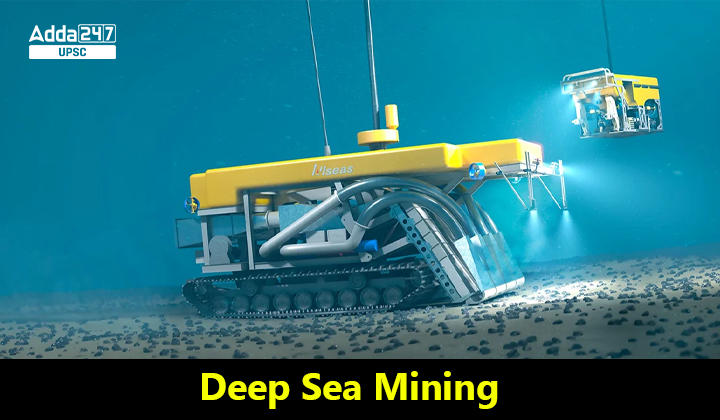Table of Contents
What is Deep Sea Mining?
According to the International Union for Conservation of Nature (IUCN), the extraction of mineral resources from the ocean below 200 meters is called Deep Sea Mining. Seabed ecosystems are not yet fully explored, and depleting terrestrial deposits amid an increasing demand for metals like lithium, cobalt, copper, nickel, and manganese has driven increased demand to explore Deep Sea Mining.
Deep Sea Mining Context
The two-year deadline for the International Seabed Authority (ISA) to finalize Deep Sea Mining rules, set in 2021, has ended. The ISA started global talks in Jamaica on Monday in what experts believe can essentially lead to the advancement of this controversial industry.
With the growing demand for metals and minerals such as cobalt, copper, gold, nickel, zinc, and rare earth elements, Deep Sea Mining has gained significant attention in recent years. Deep Sea Mining involves various methods to extract mineral resources from the seabed, including dredging, hydraulic mining, and subsea drilling.
Dredging involves the use of a large, underwater machine that sucks up sediment from the ocean floor and pumps it to the surface for processing. Hydraulic mining involves the use of high-pressure water jets to break up the ocean floor and extract minerals. Subsea drilling involves drilling into the ocean floor to access minerals beneath the surface
Deep Sea Mining How it Works
Mining interests plan to use large, robotic machines to excavate the ocean floor in a way that’s similar to strip mining on land. The materials are pumped up to the ship, while wastewater and debris are dumped into the ocean, forming large sediment clouds underwater. The slurry is then loaded onto barges and shipped to onshore processing facilities.
A New Gold Rush
- With an estimated $150 trillion in gold under our oceans, or nine pounds of gold for every person on Earth, 26 permits have now been issued by international authorities and countries around the world to begin preparations for undersea mining, focused mostly in the Pacific Ocean.
- However, deep-sea mining also has the potential to cause significant environmental damage. Deep Sea Mining is one of the most inaccessible parts of the earth, and we have very limited knowledge of its ecosystems. Mining could disrupt these ecosystems and harm the species that live there.
- In addition, Deep Sea Mining could also pollute the ocean. The mining process would generate sediment plumes that could smother marine life and disrupt food webs. The mining ships would also discharge wastewater into the ocean, which could contain harmful chemicals.
- For these reasons, there is a lot of debate about whether or not Deep Sea Mining should be allowed to proceed. Some countries, such as France and Germany, have banned deep-sea mining in their waters. Others, such as Norway, are considering opening their waters to the industry.
- The International Seabed Authority (ISA), which is the UN body that regulates Deep Sea Mining, is currently working on developing rules for the industry. These rules are expected to be finalized in 2023.
- It is still too early to say what the future of Deep Sea Mining will be. However, it is clear that the industry has the potential to be both beneficial and harmful. It is important that we carefully consider the potential environmental impacts before allowing deep-sea mining to proceed.
International Seabed Authority
- Formation: The International Seabed Authority (ISA) was formed on November 16, 1994, under the United Nations Convention on the Law of the Sea (UNCLOS).
- Type: The ISA is an intergovernmental organization.
- Headquarters: The ISA is headquartered in Kingston, Jamaica.
- Purpose: The purpose of the ISA is to regulate Deep Sea Mining and ensure the marine environment is protected from any harmful effects which may arise from mining activities.
- Main Organ: The main organ of the ISA is the Assembly of the International Seabed Authority.
Here are some of the key concerns about Deep-sea mining
- The deep sea is home to a wide variety of unique and fragile ecosystems. Mining could disrupt these ecosystems and harm the species that live there.
- Mining could also pollute the ocean. The mining process would generate sediment plumes that could smother marine life and disrupt food webs. The mining ships would also discharge wastewater into the ocean, which could contain harmful chemicals.
- We have very limited knowledge of the deep sea. This makes it difficult to assess the potential impacts of mining and to put in place adequate safeguards to protect the marine environment.
- Deep sea mining could have a negative impact on the global climate. The mining process could release methane and other greenhouse gases into the atmosphere.
It is important to weigh the potential benefits of deep-sea mining against the potential risks. If the industry is allowed to proceed, it is essential that we put in place strong safeguards to protect the marine environment.
Here are some of the ways to mitigate the risks of Deep-sea mining
- Conduct more research on the deep sea and its ecosystems. This will help us to better understand the potential impacts of mining and to put in place more effective safeguards.
- Use more environmentally friendly mining methods. For example, mining companies could use remotely operated vehicles to collect samples of the seabed, rather than using large machines that could disturb the seafloor.
- Require mining companies to take steps to minimize pollution. For example, mining companies could be required to filter wastewater before discharging it into the ocean.
- Create a system of international regulations to govern deep-sea mining. This would help to ensure that mining is conducted in a responsible manner that protects the marine environment.
Practice Question
Q. Deep Sea mining is a controversial industry with the potential to both benefit and harm the environment. Discuss the potential environmental impacts of deep-sea mining and the measures that can be taken to mitigate these impacts.
| Follow US |
|
| UPSC Govt Jobs UPSC Current Affairs UPSC Judiciary PCS Download Adda 247 App here to get the latest updates |


 UPSC Eligibility Criteria 2024- Age Limi...
UPSC Eligibility Criteria 2024- Age Limi...
 UPSC Prelims Exam Date 2024, Check New E...
UPSC Prelims Exam Date 2024, Check New E...
 UKPSC RO ARO Result 2024 Out, Download M...
UKPSC RO ARO Result 2024 Out, Download M...







